- Introduction
- Tidal Energy
- Resource
- Constraints
- Phasing
- Economic Analysis
- Conclusions
- Downloads
Tidal Energy
Overview
Tidal Energy has been used in some capacity for many years. Throughout history through the use of tidal mills, mechanical energy from tidal currents were extracted and utilized for human activities such as pumping water or crushing grain.
Only during the last century that the energy from tidal currents has been started to be extracted and converted into electricity. The only method that is currently used to generate electricity from the tides is a tidal barrage. A Tidal Barrage consists of a wall with turbines in situ. Similar to the operation of a dam a tidal barrage harnesses energy by creating a difference in water level between the inner basin and the sea and by letting water flow through the turbines during operating periods, electricity can be produced. There are a number of tidal Barrages currently in operation around the world, the most famous is the one situated at La Rance in Northern France.
A similar process can harness the energy of the tide using a structure similar to a wind turbine. In this case the kinetic energy of the tide is extracted due to the fast flowing body of water passing the turbine. This method of extraction is favourable, as it minimizes the obstruction of the flow and reduces the environmental impact on the flora and fauna.
Tidal Stream Energy
Tidal stream energy differs from tidal barrage technology because the electrical generators are installed directly into the tidal stream. This design means that there is no requirement for a wall to obstruct the flow and for this reason they have, as already said, a much smaller impact on the environment. There are various types of designs of tidal stream energy devices. These are classified as follows by the European Marine Energy Centre (EMEC) in Orkney:
- Horizontal Axis Turbines: Similar to wind turbine but with different aerodynamic shape of the blades. These are devices that can be fixed under a floating structure or standing on the bottom of the sea. Various designs have been proposed.
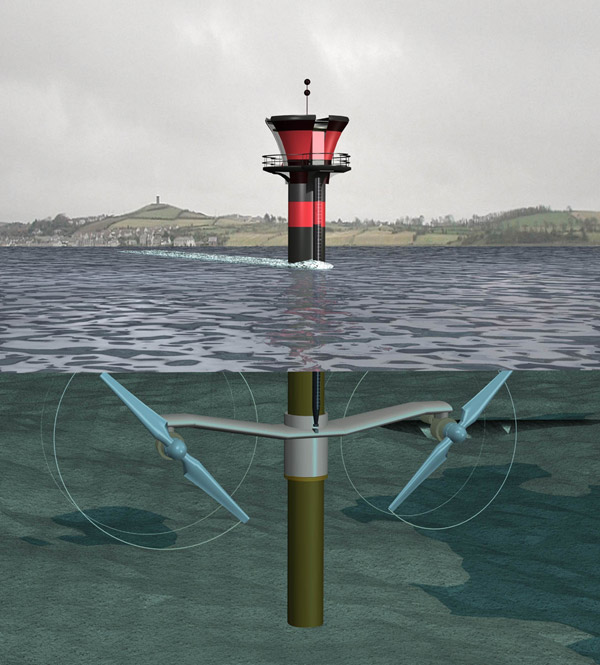
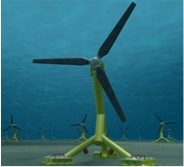
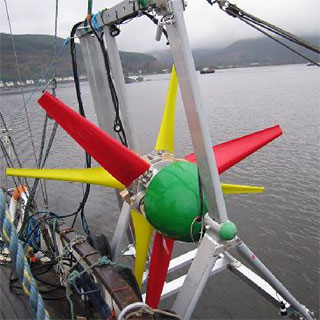
- Vertical Axis Turbines: In this case the blades are designed to be in a vertical position. One major advantage of these devices is that their motion is not dependant on the direction of the tidal stream flow.
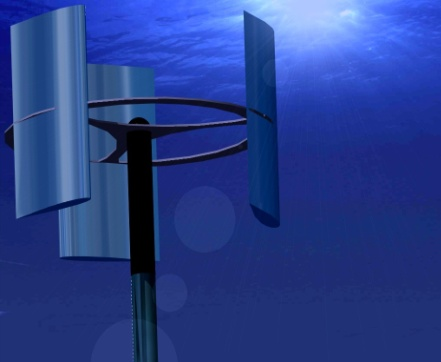
- Hydrofoil Concept Devices: Those consist in principle of a hydrofoil, which is similar in shape to an aeroplane wing. This part of the device due that the fact that is constrained to have a determined changing inclination, by interacting with the water current, produce a lift force that drives an hydraulic pump which pump a liquid at high pressure into a turbine generator and thus producing electricity.
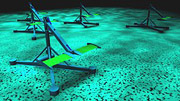
Due to the fact that tidal stream energy technology is still in its initial stage, not all devices have been optimized for commercial viability and, as vertical axis turbines is the most developed technology, we considered to focus on this latter kind of devices for concerns our project. However, we did not take into account more detailed specifications such as moorings or piles, as design parameters such as these alter the technical constraints specific to the device.
WEBSITES:
European Marine Energy Centre(EMEC)-Tidal Devices
Available at: http://www.emec.org.uk/tidal_devices.asp
IMAGES:
[1] SeaGen-Sea Generation Tidal Turbine (Left)
Available at: http://www.seageneration.co.uk
[2] Hammersfest Tidal Turbine (Middle)
Available at: http://www.hammerfeststorm.com
[3] Nautricity CoRMat Marine Current Turbine (Right)
Avaiilable at: http://www.nautricity.com
[4] The Engineering Business-Stingray Tidal Stream Energy Device
Available at: http://www.engb.com